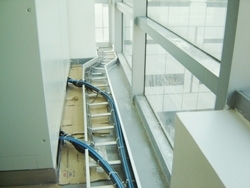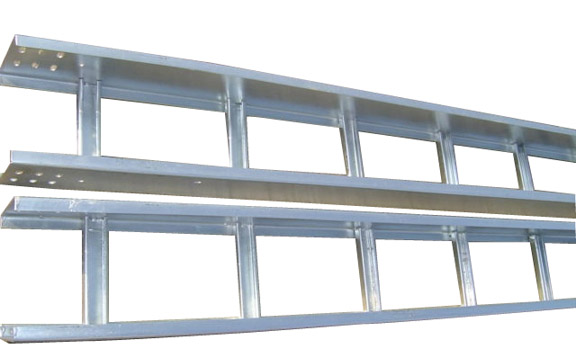鍍鋅電纜橋架設計注意標準
電纜橋架分為槽式、托盤(pán)式和梯架式、鍍鋅橋架網(wǎng)格式等結構,由支架、托臂和安裝附件等組成。建筑物內橋架可以獨立架設, 也可以附設在各種建(構)筑物和管廊支架上,應體現結構簡(jiǎn)單,造型美觀(guān)、配置靈活和維修方便等特點(diǎn),全部零件均需進(jìn)行鍍鋅處理,安裝在建筑物外露天的橋架。
Cable trays are divided into slot type, tray type, ladder type, galvanized cable tray mesh format, and other structures, which are composed of brackets, brackets, and installation accessories. The bridge in the building can be erected independently or attached to various buildings (structures) and pipe rack supports. It should reflect the characteristics of simple structure, beautiful appearance, flexible configuration, and convenient maintenance. All parts need to be galvanized and installed in the outdoor bridge outside the building.
橋架設計智能建筑的弱電系統,通常有多個(gè)信息監控和通信設施諸如樓宇自動(dòng)化、辦公自動(dòng)化、通信自動(dòng)化等相應的系統組成,除了建筑物本身的供電、供排水、空調、電梯和停車(chē)場(chǎng)等設施配置必要的信息監控外,還有安保自動(dòng)化、消防自動(dòng)化等若干個(gè)子系統,實(shí)現系統集成或部分系統集成。
Bridge design The weak current system of an intelligent building usually consists of multiple information monitoring and communication facilities such as building automation, office automation, communication automation, and other corresponding systems. In addition to the necessary information monitoring for the power supply, water supply and drainage, air conditioning, elevators, parking lots, and other facilities of the building itself, there are several subsystems such as security automation, fire automation, and other systems to achieve system integration or partial system integration.


根據建筑主體的功能需求來(lái)確定其等級和內容,這些系統包括不同類(lèi)別的電纜和導線(xiàn),其中有些是屬于有源纜線(xiàn)(電源電壓一般為DC12/24/48V和AC220V), 由于建筑行業(yè)的不斷的發(fā)展電纜橋架也在與時(shí)俱進(jìn)并不斷得到市場(chǎng)的認可和接受電纜橋架行業(yè)的國產(chǎn)化力度,產(chǎn)品選用冷軋鋼板,得到廣泛關(guān)注產(chǎn)品選用冷軋鋼板,表面工藝有冷鍍鋅、熱鍍鋅、靜電噴涂、防火涂料、烤漆等。其中產(chǎn)品廣泛用于石油化工,冶金,電力,學(xué)校通訊,高層建筑等領(lǐng)域,具有外形美觀(guān),耐腐蝕性強,通用性廣泛,安裝靈活方便,品種齊全等特點(diǎn)。
The level and content of the building body are determined based on its functional requirements. These systems include different types of cables and wires, some of which are active cables (power supply voltages are generally DC12/24/48V and AC220V). Due to the continuous development of the construction industry, cable trays are also advancing with the times and gaining market recognition and acceptance of the localization efforts of the cable tray industry. The products are made of high-quality cold-rolled steel plates, Products that have received widespread attention are high-quality cold-rolled steel plates, with surface processes such as cold galvanizing, hot galvanizing, electrostatic spraying, fireproof coating, baking paint, etc. The products are widely used in fields such as petrochemical, metallurgy, electric power, school communication, high-rise buildings, etc., with beautiful appearance, strong corrosion resistance, wide versatility, flexible and convenient installation, and a complete range of features.
電纜橋架作為承載各種電纜敷設的載體,從屬于布線(xiàn)的需要,同樣應遵循上述原則加以實(shí)施。由于建筑物內多種管線(xiàn)平行交叉,空間有限,特別是大型寫(xiě)字樓、金融商廈、酒店、場(chǎng)館等建筑,信息點(diǎn)密集,纜線(xiàn)敷設除了采用樓板溝槽和墻內埋管方式外,在豎井和屋內天棚吊頂內廣泛采用電纜橋架,提供不同走向的布線(xiàn),弱電系統的各種纜線(xiàn)分類(lèi)布放在橋架內,其路由選擇和安裝方式要根據走向的要求,并結合建筑結構和空調、電氣等管線(xiàn)協(xié)商的位置加以確定,無(wú)源纜線(xiàn)不能與有源電纜并排鋪設, 受條件所限鋪放同一橋架內。
As a carrier for carrying various types of cable laying, cable trays are subordinate to the needs of wiring, and should also be implemented in accordance with the above principles. Due to the parallel intersection of multiple pipelines in buildings and limited space, especially in large office buildings, financial malls, hotels, stadiums, and other buildings, where information points are dense, cable trays are widely used in vertical shafts and indoor ceilings, in addition to the use of floor trenches and embedded pipes, to provide wiring in different directions. Various cables for weak current systems are classified and placed within the tray, and their routing and installation methods should be based on the requirements of the direction, The location shall be determined based on the building structure and the negotiated location of air conditioning, electrical, and other pipelines. Passive cables cannot be laid side by side with active cables, and are limited by conditions to be laid within the same bridge.
其間必須采用金屬隔板分設,引出的纜線(xiàn)盡量避免平面交叉,橋架穿越樓板,墻體或伸縮縫時(shí),應該在建筑圖上標出予留相應的空洞和位置,避免因遺漏等到施工時(shí)臨時(shí)鉆空,可能傷及土建結構。為了防止電磁輻射的干擾(EMC),在橋架的設計中,應考慮橋架的封閉性。
Metal partitions must be used to separate them, and the outgoing cables should avoid plane crossing as much as possible. When the bridge passes through floors, walls, or expansion joints, corresponding holes and positions should be marked on the architectural drawing to avoid temporary drilling due to omission during construction, which may damage the civil structure. In order to prevent electromagnetic radiation interference (EMC), the closure of the bridge should be considered in the design of the bridge.









